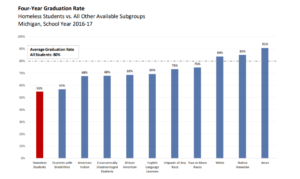Falling through the Cracks: Graduation and Dropout Rates among Michigan’s Homeless High School Students
Download PDF of full policy brief
By Jennifer Erb-Downward
Introduction
Over 3,500 high school students in the class of 2017 were homeless in Michigan. Under federal education law, all children and youth who “lack a fixed, regular, and adequate nighttime residence” are homeless. While representing a small proportion of the entire student body (3%), these students were disproportionately likely to face negative educational outcomes and accounted for almost 7% of all students who dropped out of high school.
In compliance with new regulations under the Every Student Succeeds Act (ESSA), the State of Michigan recently released graduation, dropout and attendance rate data for homeless students for school years 2012-13 through 2016-17. This policy brief examines the state’s newly available public education graduation and dropout data and finds dramatic disparities between homeless students and their low-income and non-low income peers. Across every available comparison group homeless high school students had worse educational outcomes. Given recent data that has shown student homelessness to be a statewide issue affecting rural, suburban and urban communities alike, this finding highlights the need for greater focus on a previously invisible but highly vulnerable group of students. Data for this brief are for public school students, including charters, and come from the Michigan Department of Education and the Center for Educational Performance and Information.
Key Findings
- Homeless students have the lowest four-year graduation rate of any group in Michigan for which data was available. Just over half (55%) of homeless high school students in Michigan graduated in four years. This rate was significantly lower than both the rate for economically disadvantaged students (68%) and the average graduation rate for the state as a whole (80%).
- Homeless students have the highest high school dropout rate of any group in Michigan. One in five homeless students dropped out of high school (20%), a rate six percentage points higher than that of economically disadvantaged students (14%) and 11 percentage points higher than the statewide average of 9%.
- Dropout rates for homeless students in Michigan are increasing despite downward trends among other groups. While dropout rates for both economically disadvantaged student and all students progressively declined by two percentage points from school year 2012-13 to 2016-17, the dropout rate for homeless students increased by roughly one and a half percentage points over the same time period.
- The newly released Michigan education data for graduation and dropout rates reveal homeless high school students to be a uniquely vulnerable group that has previously gone unrecognized. The educational outcomes of homeless high school students are distinct from their economically disadvantaged peers who are not homeless. Identifying the unique needs of these students is critical to improving their high school outcomes.

Conclusion
Newly released state graduation and dropout data reveal homeless high school students to be at much greater risk for not graduating from high school than their non-homeless peers. These findings combined with previous research on student homelessness in Michigan highlights the need to better identify and support homeless students so that they can succeed academically.
